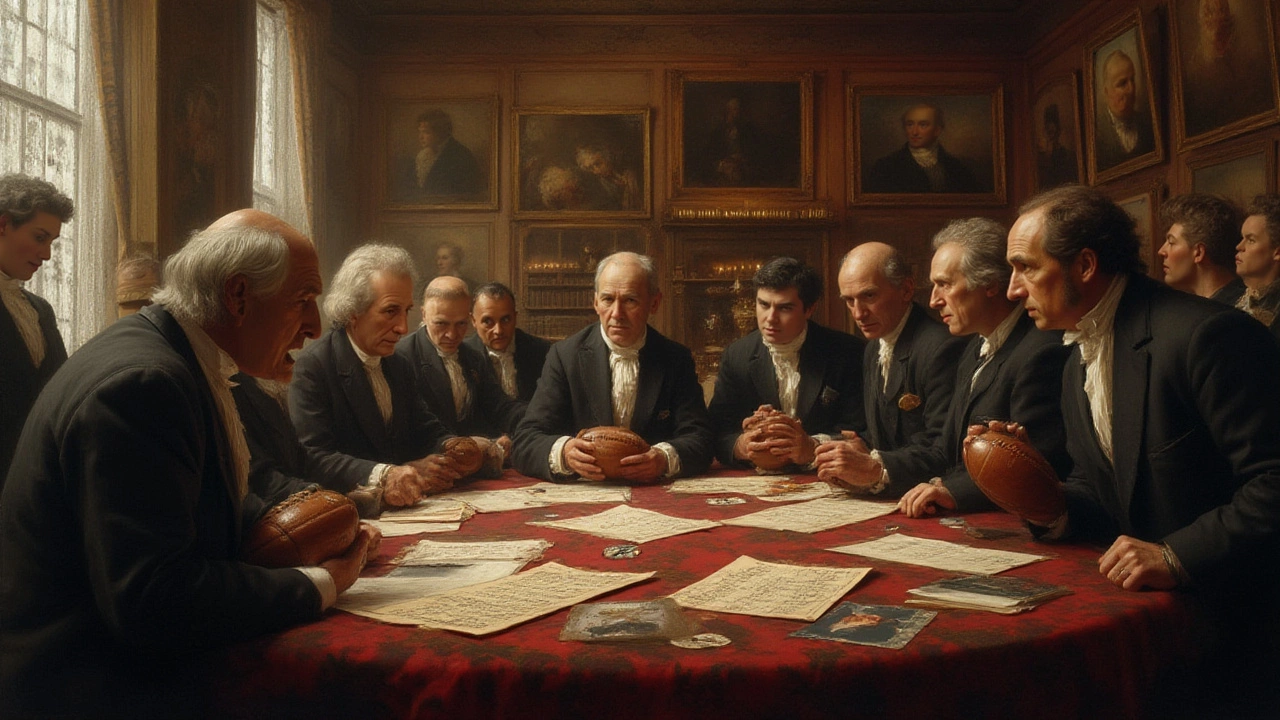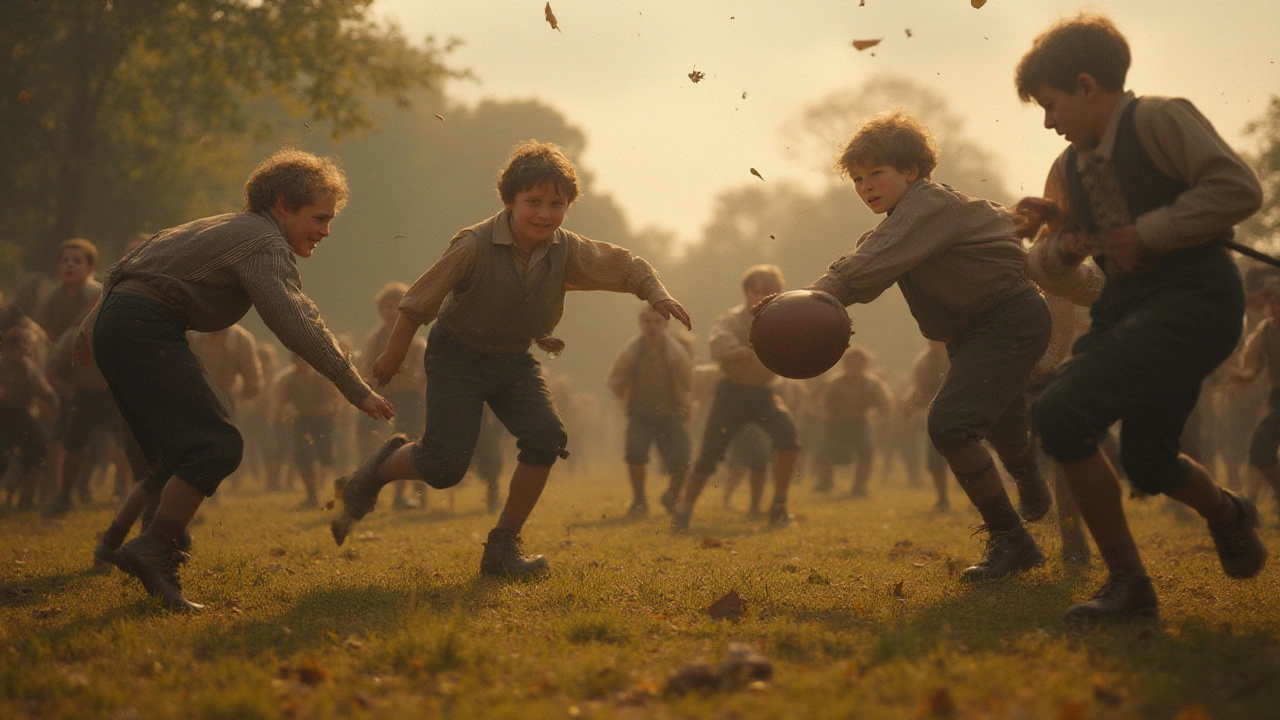Picture a muddy English field nearly two centuries ago. Boys in heavy boots grapple, kick, and chase at a ball, but no one’s quite sure what the rules are—or even if there are rules at all. You could argue these wild matches birthed not just one iconic sport, but two: football and rugby. Most people assume these games evolved on separate tracks. The truth is, their split was messy, and the answer to which came first isn’t as simple as pointing at a calendar or reading a dusty rulebook. It’s a story loaded with schoolyard mischief, regional pride, and a strange obsession with how you’re allowed to touch a ball.
The Early Chaos: Games Without a Name
Go back before Victorian England, and you’ll find a country obsessed with ball games, but completely lacking in agreement. Villages had their own traditions, from Shrovetide football in Derby to mob football in Cornwall, where hundreds would scramble through muddy streets and rivers with a pig’s bladder. These games rarely had written rules. Some let you throw the ball, some swore that was cheating, and nobody could agree on the difference between a fair tackle and a flat-out brawl.
It wasn’t just about scoring goals or tries—it was about pride, rivalry, and letting off steam. One famous record traces back to 1170, when William FitzStephen described crowds "of every age" running at a ball in London. The same wild energy ran through medieval universities like Oxford and Cambridge, where students would often invent more rules to try to outdo their rivals. At the heart of this chaos were two instincts: kick the ball or carry it. That split kept popping up: Should you use your hands, or just your feet?
The first actual attempt to organize things came in English public schools, which acted like sports labs during the 1700s and early 1800s. Each school made its own code. At Eton, you couldn’t touch the ball with your hands, but at Rugby School they actually encouraged it. That was the petri dish where both modern football and rugby started to take recognizable shape. If you could sneak back and watch those games in the 1820s, you’d see a hybrid: scrums, drop-kicks, goal posts—chaotic, but close relatives of what we watch today.
The Big Break: Codifying the Rules
By the 1840s, the confusion was driving everyone a bit mad, especially as boys who’d learned one set of rules at Harrow would come home and fight with mates who went to Rugby or Eton. So, in 1863, a group of clubs and schools met in a London tavern—the Freemasons’ Tavern, just off Great Queen Street. Their plan: roll up the best ideas into a single, official rulebook.
This is where football as we know it—“association football,” or simply “football” (soccer to Americans)—got its fresh start. The new Football Association rules banned running with the ball in your hands and outlawed hacking (kicking opponents in the shins, which was weirdly popular). Some clubs hated these new restrictions, especially the bit about picking up the ball. These dissenters walked out. Fast-forward a few years, and in 1871, those same clubs and players created the Rugby Football Union. In other words, both sports broke off from the same family reunion, arguing about whether hands were allowed at the dinner table.
If you’re keeping score, the first official football rules were set in 1863, while rugby’s first real union formed in 1871. But here’s the kicker: the version of football being played throughout Britain until that fateful Tavern meeting was a jumbled mess that included both kicking and handling—and everyone called it “football.” So, if you’re asking what came first, the tradition of playing football where you could run with the ball definitely existed before 1863. The clean split between the two—football without hands, and rugby with hands—only became official after years of heated arguments and walkouts.
This is where myths creep in. You’ll hear that a boy called William Webb Ellis invented rugby in 1823 by picking up the ball and running with it at Rugby School. While there was indeed a William Webb Ellis, the earliest mention of his “cheat” doesn’t appear until 1876. No teachers from the time wrote about it, and even the first historians of the sport called the story “apocryphal.” Instead, it was the ongoing debate about rules—fueled by dozens of schools and fiercely competitive clubs—that made rugby and association football split apart. Neither one suddenly appeared out of nowhere; both are descendants of England’s wild schoolyard games.

Rugby and Football Take Separate Paths
Once the rules were written down, each sport went its own way—fast. The Football Association’s game (let’s just call it “football” from here, since this is the version the rest of the world calls “football” and the Americans call “soccer”) took off like wildfire among working-class communities in the north. Cheap equipment, simple rules, and the thrill of a Saturday match drew huge crowds. By 1888, there was a national football league in England, and before the turn of the century, international matches and cup competitions were all the rage.
Rugby stuck closer to its roots in the public schools and the old boys’ networks of southern England, but soon the north started to shape the game. In 1895, a huge split created two different kinds of rugby: union and league, because working-class players in northern England wanted to be paid for missing work when they played. Rugby Union stayed amateur for another century, while Rugby League allowed payment for players and tweaked the rules—fewer players, different scoring—to speed up the game and cut down on big scrums.
The two sports also carried different values. Football was all about simple, open play and team strategy—keep possession, pass, and score. Rugby, on the other hand, made a virtue out of physical toughness, tactical scrums, and team discipline. Even today, you see these ties to class and culture in England. Football stadiums are spread across almost every city, reflecting working people’s attachment to their clubs. Rugby has a loyal following in old university towns, parts of the north, and overseas in rugby nations like New Zealand, South Africa, and Australia.
There have been countless crossovers, too. Lots of today’s footballing nations—like Brazil and Spain—saw both games introduced by British sailors and factory owners in the late 1800s, but it was football that caught on thanks to its accessibility and international spirit. Rugby kept a firmer grip in places that prized its traditions, like Japan’s school system or French universities in the southwest.
Weird Facts, Misconceptions, and Modern-Day Connections
Ask at the pub and you’ll hear all sorts of tall tales: “Rugby is older than football,” or “Football banned all violence, that’s why it’s so different.” Proven facts tell a muddier story. Those early centuries were a gigantic mash-up, and most historians agree that the same mob-football games in medieval England evolved into both rugby and football. If you had joined a schoolboys’ match in the 1820s, you would have recognized both a rugby-style scrum and football-style kicks—sometimes in the same play.
Here’s a tip: next time you’re watching a match, see how the layout and scoring system hints at old traditions. The end goal in rugby is called a "try," because in the earliest days, crossing the line allowed you to try for a kick through the posts. In football, the word "goal" stuck because no one was allowed to touch the ball with their hands. Even the shape of the balls was unplanned—early footballs were made out of leather bladders, and the difference in manufacturing caused the rounder football and the more oval rugby ball.
The two games are now played in about 200 countries each, but with completely separate fan bases and world tournaments—the FIFA World Cup and the Rugby World Cup can each bring an entire country to a standstill. Yet, they still share a head-spinning number of terms: both have "scrums," "tackles," and "goals," though they mean different things. And there’s a curious overlap in player skills; some athletes, like Welshman Jonathan Davies and Australian Wendell Sailor, have starred in both codes of rugby and even dabbled in professional football.
Misconceptions spread fast. One of the most common? The idea that football is a gentler, modern invention, while rugby harks back to some ancient English warrior trial. Fact is, neither can claim to be truly ancient or shockingly modern. Both are just the latest chapters in England’s love affair with ball games, shaped more by disagreements over schoolyard rules than by acts of parliament or heroes like William Webb Ellis.
So, what came first—English football or rugby? The honest answer is that neither really did. They’re two branches of the same tree, split when English schoolmasters and players argued about nothing more than what counted as fair play. The differences we see today flashed into life in that smoky London tavern back in the 1860s, but the origins run right through English mud, village chaos, and the stubborn refusal to do things any way but your own.


